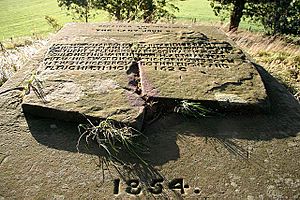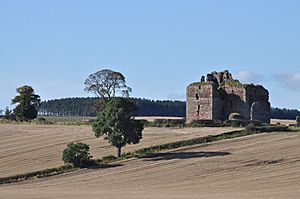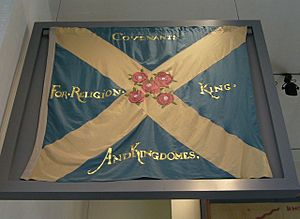Henry Hall (Covenanter) facts for kids
Quick facts for kids Henry Hall of Haughhead |
|
|---|---|

Jehovah Nissi
For Christ & His Truths No Quarters For The Active Enemies Of The Covenant |
|
| Personal details | |
| Died | 1680 |
| Denomination | Presbyterian |
Henry Hall was an important Scottish Covenanter and a leader in the Church of Scotland. He strongly believed in the Presbyterian way of running the church. He tried to join the Pentland Rising, a rebellion, but was stopped. He later fought as an officer in two major battles: Drumclog and Bothwell Bridge.
Henry Hall was part of a group, including Richard Cameron and Donald Cargill, who openly disagreed with the government's rules about religion. He was captured at South Queensferry when Robert Middleton, the governor of Blackness Castle, tried to arrest him and Donald Cargill. Hall fought off the governor, allowing Cargill to escape. However, Hall was badly hurt on the head by a taxman and later died. A paper called The Queensferry Paper was found on him. This paper caused a lot of trouble for the government when they read it.
Contents
Who Was Henry Hall?
Henry Hall of Haughhead was a Covenanter and a landowner. Covenanters were Scottish people who signed agreements, or "covenants," to protect the Presbyterian Church. Henry was the son of Robert Hall, who owned land called Haughhead. This land was near the Kale Water in a place called Eckford.
The old house at Haughhead is now in ruins, but it was lived in for a long time. Near the house, there's a special stone with writing on it. It tells a story from 1620 about Henry's father, Hobbie Hall, and how he protected his land from powerful neighbours. Henry's family was well-known in the border areas of Scotland.
Early Life and Beliefs
Henry Hall was a very religious person. He didn't agree with some changes made in the church in 1651. Because of this, he stopped going to his local church in Eckford. Instead, he traveled to Ancrum every week to hear a minister named John Livingstone.
When King Charles II brought back the Episcopal way of running the church (with bishops), Henry Hall stayed loyal to the Presbyterian ministers. This made the government unhappy. In 1665, he had to hide across the border in England, but still close to his home.
Henry left his hiding place to join the Covenanters fighting in the Pentland Rising in 1666. He was arrested and put in Cessford Castle, which was only a few miles from his home. Luckily, the Earl of Roxburghe, who owned the castle, helped him get released.
After his release, Hall went back to Northumberland. He was involved in a fight there where a friend was killed. This forced him to leave the area again. He returned to Scotland and often traveled with Donald Cargill and other Covenanter ministers. They held secret outdoor church meetings, called conventicles, on his land. His estate was a good place for these meetings because it was hidden and close to the border hills, where they could escape if soldiers came. It was here that Richard Cameron was allowed to preach for the first time.
Fighting for His Beliefs
Henry Hall was one of four Covenanter leaders who met at Shawhead Muir on June 18, 1679. They worked with ministers like Cargill to write down why they believed God was angry with the country.
He was also a commanding officer in the Covenanter army. He led soldiers from the first fight at Drumclog until their defeat at Bothwell Bridge in June 1679. The blue silk flag he carried in battle was later kept by a family in Moffat.
On June 25, 1679, the Scottish government ordered a search for Henry Hall. But he managed to escape to the Netherlands. He returned to Scotland about three months later.
Capture and Death
Henry Hall spent a lot of time near Bo'ness with Donald Cargill. The government found out they were in the area from local church ministers. On June 3, 1680, Robert Middleton, the governor of Blackness Castle, followed them to an inn in South Queensferry.
Middleton pretended to be friendly and invited them to have a glass of wine. But once they sat down, he announced they were his prisoners. He asked the people in the inn to help him, but everyone refused except for an excise officer (a tax collector). This officer helped Middleton close the gates until his soldiers arrived.
The noise inside the inn made the women in the neighborhood suspicious. They broke open the outer gate. Henry Hall bravely held off Governor Middleton, allowing Donald Cargill to escape safely. As Hall was getting away, the tax collector, Thomas George, hit him on the head with a gun, causing a serious injury.
Despite his wound, Hall managed to get outside. The women helped him and took him out of town. He walked a few steps but then fainted. He was taken to a nearby house. General Dalziel, a government general, lived close by. He came with his guards and, even though it was clear Hall was dying, took him prisoner to Edinburgh. Henry Hall died on the way. His body was taken to the Canongate Tolbooth (a prison) and stayed there for three days. His friends secretly buried him at night.
The Queensferry Paper
When Henry Hall was captured, a very important document was found on him. It became known as the Queensferry Paper because of where it was found. Donald Cargill didn't officially say it was his, and it wasn't signed, but most people believe he wrote it.
The Queensferry Paper shocked the government. In it, the people who agreed with it said they would no longer be loyal to the king or the government. Instead, they promised to defend their own rights and freedoms. Some people see this paper as an early declaration of religious freedom and the right to defend oneself. Others point out its strong political ideas, which were similar to the Sanquhar Declaration made later on June 22, 1680.
Family Members
- Robert Hall was Henry's son.
- George Hall was Henry's grandson, born in 1680. He became a minister.
- Robert Hall (1763-1824) was a famous great-grandson of Henry Hall.




